Guitar
Here is a very very rare bass from the early days of Vox/JMI - the short-scale Bassmaster.
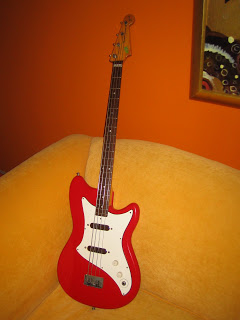
Vox began as an amplifier company in the late 1950s, based in Kent, England - but around 1961 they decided to branch out into electric guitars and basses. These earliest Vox instruments were fairly simple and were manufactured for Vox by a cabinet maker in Shoeburyness, Essex (if anyone has the name, please let me know!!).
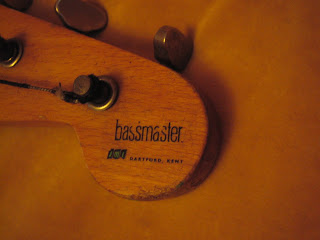
These instruments featured solid mahogany bodies, with sycamore necks and rosewood fretboards. The necks did not have an adjustable truss rod, but I'm assuming there is a fixed truss rod within the neck.
Around 1963 Vox expanded its lineup of instruments with the famous teardrop Mark VI and the Phantom series of guitars and basses, though these used necks manufactured by EKO and imported to the UK, combined with bodies and hardware made in England. These instruments were also assembled in the Dartford, Kent plant, with no involvement of the cabinet maker responsible for the Bassmaster.
By 1967, Vox had shifted all instrument manufacturing to Italy, at the EKO plant. The Bassmaster model was reworked into the single-pickup Panther bass at this time, and built by EKO.
When I got this particular bass, it had a number of issues, but was in surprisingly good condition for being 46 years old - and not having a case !!
The main issues were:
- loose fret ends that were popping up
- two missing pearl inlays on the fretboard
- a missing tuner and missing tuner button on the original tuners
- action that was a bit too high
- one neck screw broken off in the neck
The neck however was straight and the bass sounded good - boomier than I would have guessed !!
The first order of business was to get the neck fixed up. I found a set of Van Ghent tuners from a Hagstrom guitar, which fit well with the existing tuner ferrules, looked good and didn't require any additional holes to be drilled in the headstock. I saved the original tuners just in case someone out there comes up with a spare one someday !!
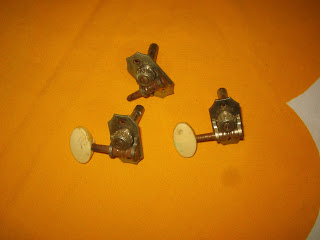
Then came the frets and the inlays. This picture shows the popped-up fret ends and missing inlays.
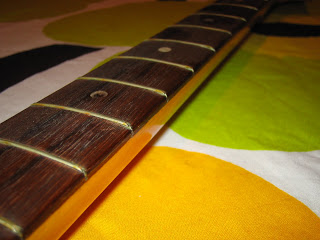
Since I needed to install two new pearl dots and file them down to the proper contour, I decided to carefully remove ALL the frets - and save them for reinstallation.
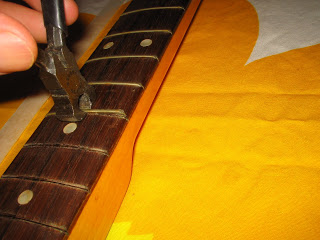


The fretwire was very fine, but the frets were actually in great shape with minimal wear.
Once the inlays were flush, I lightly sanded the entire board, oiled it - and then cleaned out the fret slots with the back of an Xacto knife prior to reinstalling the frets. Note that I affixed the frets to a piece of tape to keep them in the proper order for reinstallation.
I re-bent each fret to slightly over radius them - and cut some clamping cauls to match the 6 inch radius (!!) of the fretboard. In the end, I only used the clamping cauls on a few of the frets - a little bit of Franklin Hide Glue on each fret followed by hammering them in - working from one edge to the other - worked great.
I was careful to line up one end of the fret with the edge of the fretboard - and then tap it in across the board. In the end I only had a few little burrs sticking out that I had to touch up with a fret-end file.
The final neck work was to dig out the remnants of a neck screw that had broken off in the neck - which required some drilling next to the screw to get a grip with needle nose pliers - and then doweling to repair the damage.
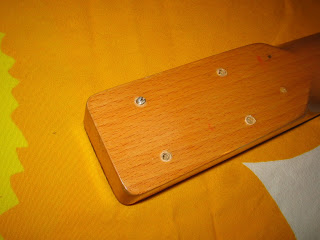
I found a stainless steel screw that was a near match for the remaining three original neck screws.

The body needed little work - just some cleaning with some ScratchX to get off 40 year old grime - and one area where it looked like a sticker had been scraped off was wet sanded and then buffed out. The finish has some deep checking - but is solid and not flaking off at all.
The body also had shielding paint applied under the pickguard - I have no idea if this is original or was a mod from later on. I did find that the ground wire from the bridge was MISSING - so I added one, using the existing passage to run it from the bridge to the controls. The mahogany is visible in the unpainted neck pocket area.
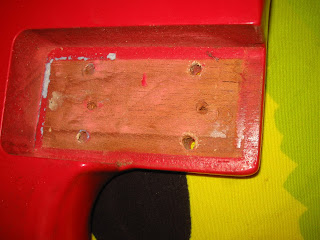
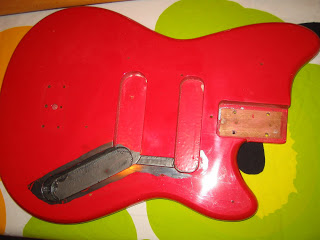
The electronics appear entirely original - there was some mention that the potentiometers are actually desirable for the restoration of old old Marshall amps - but again I profess ignorance on that topic!

Finally - re-assembly time came. As I mentioned, the action on the bass was too high initially, and this was due to a shallow neck set. To change the angle on the neck, I fitted a plastic shim made from some old thin pickguard material - probably around 0.03 inches thick.
Once the bass was strung up with some flat wounds - I adjusted the intonation, which actually came out pretty close ! I also had to do a little fret filing in just two places - the end of one fret and the middle of one of the highest frets - not bad for recycling the original frets!
The bass plays surprisingly well - and with the flat-wounds has a kind of Hofner-esque tone.
The neck is VERY skinny - more akin to a Tele or Mustang GUITAR neck than a bass neck, but comfortable. This diminutive bass weighs in at a grand total of 6 lbs!
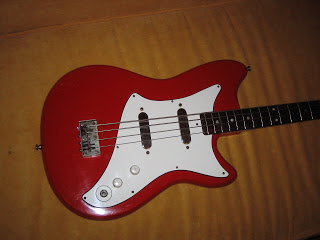
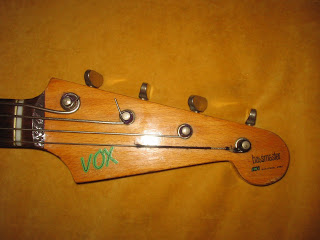
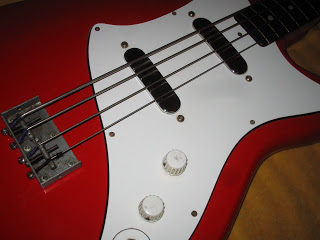

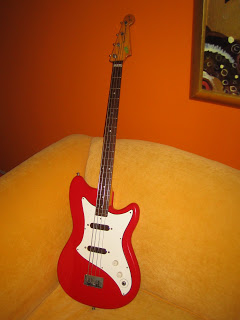
I'm asking $350 plus shipping for this instrument - it will come with an inexpensive gig bag. You will NOT find another one of these around !!
- Vintage & Rare Guitar Of The Week: Mosrite 350 Mono Bass From 1973
guitarz.blogspot.com: I figured it was high time we looked at another bass, and so present the above-pictured for you. Although it's not a bass that you see every day I'm sure that most everyone reading this blog knows who it was made by...
- Saving A Fretless, 9-string 1963 Fender Jaguar Neck !!
A friend of mine was able to purchase a "project" Jaguar for a very reasonable price - the Jaguar was fitted with a WD replacement neck but also had the original and much abused neck sitting in the case. I decided to see if I could repair the original...
- 1981 Fender Jazz Bass - Last Of The Fullerton Fenders
Though many "vintage" types out there consider 1980 to be the absolute end of the historic Fender period, many Fender instruments from the early 80s remained essentially the same as Fenders from the 1970s. This 1981 Jazz bass is an excellent example of...
- One Way To Repair A Fender Trussrod - 63 Jazz Bass Neck
I did this repair as part of a complex deal to get a slab-board Fender Precision P-bass/Jazz bass neck with a C.A.R. headstock. Anyone have a spare C.A.R. P-bass body hanging around ? :) So anyway - the truss rod on this bass apparently broken at the...
- 1978 Musicmaster Bass Project
(originally posted 8. October 2007 on http://s217476017.onlinehome.us/) Hi there, I decided that a blog would be a more flexible forum for me to not only share info and pictures covering guitar projects I'm working on, but also just generally...
Guitar
For Sale: 1963 Vox Bassmaster Bass, English-made
Here is a very very rare bass from the early days of Vox/JMI - the short-scale Bassmaster.

Vox began as an amplifier company in the late 1950s, based in Kent, England - but around 1961 they decided to branch out into electric guitars and basses. These earliest Vox instruments were fairly simple and were manufactured for Vox by a cabinet maker in Shoeburyness, Essex (if anyone has the name, please let me know!!).

These instruments featured solid mahogany bodies, with sycamore necks and rosewood fretboards. The necks did not have an adjustable truss rod, but I'm assuming there is a fixed truss rod within the neck.
Around 1963 Vox expanded its lineup of instruments with the famous teardrop Mark VI and the Phantom series of guitars and basses, though these used necks manufactured by EKO and imported to the UK, combined with bodies and hardware made in England. These instruments were also assembled in the Dartford, Kent plant, with no involvement of the cabinet maker responsible for the Bassmaster.
By 1967, Vox had shifted all instrument manufacturing to Italy, at the EKO plant. The Bassmaster model was reworked into the single-pickup Panther bass at this time, and built by EKO.
When I got this particular bass, it had a number of issues, but was in surprisingly good condition for being 46 years old - and not having a case !!
The main issues were:
- loose fret ends that were popping up
- two missing pearl inlays on the fretboard
- a missing tuner and missing tuner button on the original tuners
- action that was a bit too high
- one neck screw broken off in the neck
The neck however was straight and the bass sounded good - boomier than I would have guessed !!
The first order of business was to get the neck fixed up. I found a set of Van Ghent tuners from a Hagstrom guitar, which fit well with the existing tuner ferrules, looked good and didn't require any additional holes to be drilled in the headstock. I saved the original tuners just in case someone out there comes up with a spare one someday !!

Then came the frets and the inlays. This picture shows the popped-up fret ends and missing inlays.

Since I needed to install two new pearl dots and file them down to the proper contour, I decided to carefully remove ALL the frets - and save them for reinstallation.



The fretwire was very fine, but the frets were actually in great shape with minimal wear.
Once the inlays were flush, I lightly sanded the entire board, oiled it - and then cleaned out the fret slots with the back of an Xacto knife prior to reinstalling the frets. Note that I affixed the frets to a piece of tape to keep them in the proper order for reinstallation.
I re-bent each fret to slightly over radius them - and cut some clamping cauls to match the 6 inch radius (!!) of the fretboard. In the end, I only used the clamping cauls on a few of the frets - a little bit of Franklin Hide Glue on each fret followed by hammering them in - working from one edge to the other - worked great.
I was careful to line up one end of the fret with the edge of the fretboard - and then tap it in across the board. In the end I only had a few little burrs sticking out that I had to touch up with a fret-end file.
The final neck work was to dig out the remnants of a neck screw that had broken off in the neck - which required some drilling next to the screw to get a grip with needle nose pliers - and then doweling to repair the damage.

I found a stainless steel screw that was a near match for the remaining three original neck screws.

The body needed little work - just some cleaning with some ScratchX to get off 40 year old grime - and one area where it looked like a sticker had been scraped off was wet sanded and then buffed out. The finish has some deep checking - but is solid and not flaking off at all.
The body also had shielding paint applied under the pickguard - I have no idea if this is original or was a mod from later on. I did find that the ground wire from the bridge was MISSING - so I added one, using the existing passage to run it from the bridge to the controls. The mahogany is visible in the unpainted neck pocket area.


The electronics appear entirely original - there was some mention that the potentiometers are actually desirable for the restoration of old old Marshall amps - but again I profess ignorance on that topic!

Finally - re-assembly time came. As I mentioned, the action on the bass was too high initially, and this was due to a shallow neck set. To change the angle on the neck, I fitted a plastic shim made from some old thin pickguard material - probably around 0.03 inches thick.
Once the bass was strung up with some flat wounds - I adjusted the intonation, which actually came out pretty close ! I also had to do a little fret filing in just two places - the end of one fret and the middle of one of the highest frets - not bad for recycling the original frets!
The bass plays surprisingly well - and with the flat-wounds has a kind of Hofner-esque tone.
The neck is VERY skinny - more akin to a Tele or Mustang GUITAR neck than a bass neck, but comfortable. This diminutive bass weighs in at a grand total of 6 lbs!





I'm asking $350 plus shipping for this instrument - it will come with an inexpensive gig bag. You will NOT find another one of these around !!
- Vintage & Rare Guitar Of The Week: Mosrite 350 Mono Bass From 1973
guitarz.blogspot.com: I figured it was high time we looked at another bass, and so present the above-pictured for you. Although it's not a bass that you see every day I'm sure that most everyone reading this blog knows who it was made by...
- Saving A Fretless, 9-string 1963 Fender Jaguar Neck !!
A friend of mine was able to purchase a "project" Jaguar for a very reasonable price - the Jaguar was fitted with a WD replacement neck but also had the original and much abused neck sitting in the case. I decided to see if I could repair the original...
- 1981 Fender Jazz Bass - Last Of The Fullerton Fenders
Though many "vintage" types out there consider 1980 to be the absolute end of the historic Fender period, many Fender instruments from the early 80s remained essentially the same as Fenders from the 1970s. This 1981 Jazz bass is an excellent example of...
- One Way To Repair A Fender Trussrod - 63 Jazz Bass Neck
I did this repair as part of a complex deal to get a slab-board Fender Precision P-bass/Jazz bass neck with a C.A.R. headstock. Anyone have a spare C.A.R. P-bass body hanging around ? :) So anyway - the truss rod on this bass apparently broken at the...
- 1978 Musicmaster Bass Project
(originally posted 8. October 2007 on http://s217476017.onlinehome.us/) Hi there, I decided that a blog would be a more flexible forum for me to not only share info and pictures covering guitar projects I'm working on, but also just generally...
